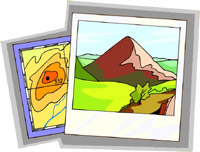
Worksheets and No Prep Teaching Resources
Reading Comprehension Worksheets
Landforms
Geography

Landforms
 Worksheets and No Prep Teaching Resources Reading Comprehension Worksheets Landforms Geography |
 Landforms |
| edHelper's suggested reading level: | grades 5 to 7 | |
| Flesch-Kincaid grade level: | 7.41 |
|
Exploring North America - The Landforms
By Trista L. Pollard |

|
 1 Early explorers who came to North America saw its different physical features. In fact, if you travel across the continent, you will see its variety of landforms. There are mountains, deserts, canyons, valleys, and plains. They also saw the Native American communities that existed in North America. These people were familiar with North America's landscape. Early explorers had to learn how to navigate these physical features.
1 Early explorers who came to North America saw its different physical features. In fact, if you travel across the continent, you will see its variety of landforms. There are mountains, deserts, canyons, valleys, and plains. They also saw the Native American communities that existed in North America. These people were familiar with North America's landscape. Early explorers had to learn how to navigate these physical features. |
Create Weekly Reading Books
Prepare for an entire week at once! |
| Leave your feedback on Exploring North America - The Landforms (use this link if you found an error in the story) |
 |
Landforms
|
 |
Geography
|
 |
Science
|